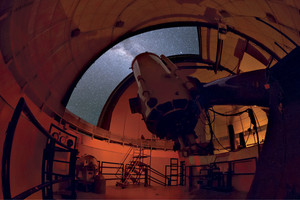
CARNEGIE INSTITUTION FOR SCIENCE
The Swope Telescope, which has a 1-meter reflector and has been operating in Chile since 1971, was the first to find the galaxy where the event occurredCARNEGIE INSTITUTION FOR SCIENCEOver the last 10 years, astrophysicists from ground and space observatories all over the world, including various satellites and telescopes, have signed scientific collaboration agreements with the LIGO and Virgo observatories, which operate the world’s three major gravitational wave detectors. When a signal with a high chance of being caused by gravitational waves is recorded, the network of partners is notified of the estimated mass and luminosity of the probable source objects via a circular, as well as receiving a map of the sky with the likely location of the phenomenon. Their mission is to search space for electromagnetic radiation—any form of light—released by the cosmic event that produced the gravitational waves.
By mid-August this year, four gravitational wave recordings had been confirmed. They all resulted from merging black holes, a phenomenon that should not produce any form of light. As expected, the LIGO-Virgo network did not observe any electromagnetic radiation from any of these collisions. But the event on August 17 was different: its unique characteristics made it easy to detect, locate, and observe in detail. For the first time, astrophysicists recorded cosmic signatures caused by the collision and merging of a pair of neutron stars.
The theory, which proved correct, is that such a phenomenon should produce two types of emission almost simultaneously: the highly sought gravitational waves, followed by a visible explosion of gamma rays. “You want the gamma-ray burst to come after the gravitational waves because first you have to smash the objects together, then the material is warmed up, and then you get the radiation,” said Salvatore Vitale, from the Massachusetts Institute of Technology (MIT), one of the researchers at LIGO, when the discovery was announced. “So you would expect to see the gravitational waves first.” After the explosion of gamma rays—the first type of light generated by the phenomenon—other forms of electromagnetic radiation should also be produced, such as visible light, ultraviolet light, and radio waves. But to record these other forms of radiation, the origin of the phenomenon had to first be located in space.
The first sign that a collision of neutron stars had occurred in some corner of the cosmos arrived at 12:41:04 p.m. (UTC) on August 17. The three LIGO-Virgo detectors, two of which are located in the USA and one in Europe, registered a signal considered a strong candidate to be a gravitational wave, which appeared to have originated from the merging of two neutron stars. Situated on the outskirts of Pisa, Italy, the Virgo interferometer, which had just been upgraded and had returned to operations only two weeks earlier, was the first to detect a weak signal of the anomaly. Twenty-two milliseconds later, the LIGO detector in Livingston, Louisiana, also recorded the gravitational waves, and three milliseconds after that, the second LIGO detector in Hanford, Washington, detected the signal. It was the Hanford observatory, the last of the three to record the phenomenon, that observed the most intense signal and sent the first automatic notice that potential gravitational waves had been detected.
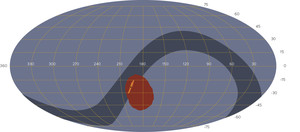
NASA / ESO
Map of the sky showing the area where the collision probably occurred according to data from the INTEGRAL (dark grey) and Fermi (red) gamma-ray space telescopes, and the LIGO/Virgo detectors (orange). The star inside the orange area represents galaxy NGC 4993NASA / ESOA brief explosion of gamma rays
While gravitational wave detectors processed the signal from space, two satellites that specialize in recording gamma-ray bursts identified a small event. Fermi, a NASA space telescope that maps the entire sky every three hours, recorded a gamma-ray burst 1.7 seconds after the LIGO-Virgo detectors captured the gravitational waves, and issued an automatic alert. Every year, the Fermi telescope detects about 240 gamma-ray bursts, of which 40 are categorized as short bursts (less than 2 seconds), like those observed on August 17. This brief explosion was the closest to Earth that the satellite has ever recorded. Another space telescope, the International Gamma-Ray Astrophysics Laboratory (INTEGRAL), operated by the European Space Agency (ESA) in cooperation with the USA and Russia, also confirmed the explosion seen by Fermi. The near simultaneous recordings of gravitational waves and a gamma-ray burst left little doubt that both originated from the same event.
At 1:21 p.m., 40 minutes after the automatic detections, a circular posted by the LIGO-Virgo collaboration notified the astrophysicist community that a likely gravitational wave emission had been detected. The text also mentioned the gamma-ray burst recorded by the Fermi satellite. This was the alert that the LIGO-Virgo partners had been waiting for, and they immediately began to search for the location of the stellar merger. Over the next few hours, a number of circulars provided updated data on the phenomenon.
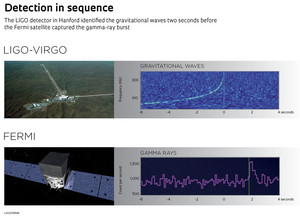 Clue offered by a blind spot
Clue offered by a blind spot
Initially, with only the data from the Fermi and INTEGRAL satellites, the potential area that the event could have occurred was enormous, which made determining its exact location extremely difficult. But once the LIGO-Virgo measurements were refined, the likely area of origin was narrowed down to 28 square degrees, an area equivalent to 140 full moons seen from Earth. The distance at which the collision of stars occurred was also quickly calculated at about 130 million light-years from Earth.
Despite only recording a weak signal of the gravitational waves, the Virgo observatory played an important role in establishing the area of the sky in the southern hemisphere where the event occurred. The information provided by Virgo and the other two detectors was used to triangulate the origin of the phenomenon. “The breadth and timing of the signal were used to locate its source,” says Dutch physicist and Virgo spokesman Jo van den Brand, from Vrije Universiteit Amsterdam. The gravitational waves were only faintly picked up by the European detector because the neutron star collision occurred in one of its four blind spots, a fact that was also an important clue in determining the area of origin. “At the time, we did not know that it would be our most important contribution, but without Virgo, it would have been very difficult to locate the source of the gravitational waves,” he said.
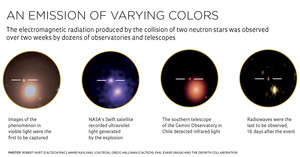 With the best possible range of coordinates for discovering the source of the gravitational waves and gamma-ray burst, astrophysicists with access to telescopes in the southern hemisphere began hunting for the origin of the phenomenon. The race was won by the One-Meter Two-Hemispheres (1M2H) Collaboration, led by astrophysicist Ryan Foley, from the University of California in Santa Cruz. The discovery involved 17 members of the team, which specializes in studying the light from supernovae (explosions of massive stars). Less than 11 hours after the gravitational waves were detected, Foley and his team identified a new spot of light on the outskirts of galaxy NGC 4993 in the Hydra constellation. “We had a well-defined strategy: to focus on the galaxies, because that is where the stars are,” says Foley. “Luck favors the prepared, and we were ready.” There were about 50 galaxies in the search field.
With the best possible range of coordinates for discovering the source of the gravitational waves and gamma-ray burst, astrophysicists with access to telescopes in the southern hemisphere began hunting for the origin of the phenomenon. The race was won by the One-Meter Two-Hemispheres (1M2H) Collaboration, led by astrophysicist Ryan Foley, from the University of California in Santa Cruz. The discovery involved 17 members of the team, which specializes in studying the light from supernovae (explosions of massive stars). Less than 11 hours after the gravitational waves were detected, Foley and his team identified a new spot of light on the outskirts of galaxy NGC 4993 in the Hydra constellation. “We had a well-defined strategy: to focus on the galaxies, because that is where the stars are,” says Foley. “Luck favors the prepared, and we were ready.” There were about 50 galaxies in the search field.
The optical source was captured by the small, old Swope Telescope at the Carnegie Institution’s Las Campanas Observatory in Chile, some 600 kilometers north of the capital, Santiago. Situated at the top of a mountain almost 2,400 meters above sea level, the Swope Telescope was inaugurated in 1971 and uses a 1-meter mirror. Its field of view, however, is relatively large. It covers 0.25 square degrees of the sky, equal to a little more than one full moon seen from Earth. “There was no way I could miss it [the light source]. It was like waving a finger in front of your eye,” Foley exaggerates. Using the much more powerful Blanco telescope in Cerro Tololo, Chile, a team coordinated by Brazilian physicist Marcelle Soares-Santos, from Brandeis University, USA, took 10 minutes longer than the 1M2H group to find the light spot in galaxy NGC 4993 (see interview).
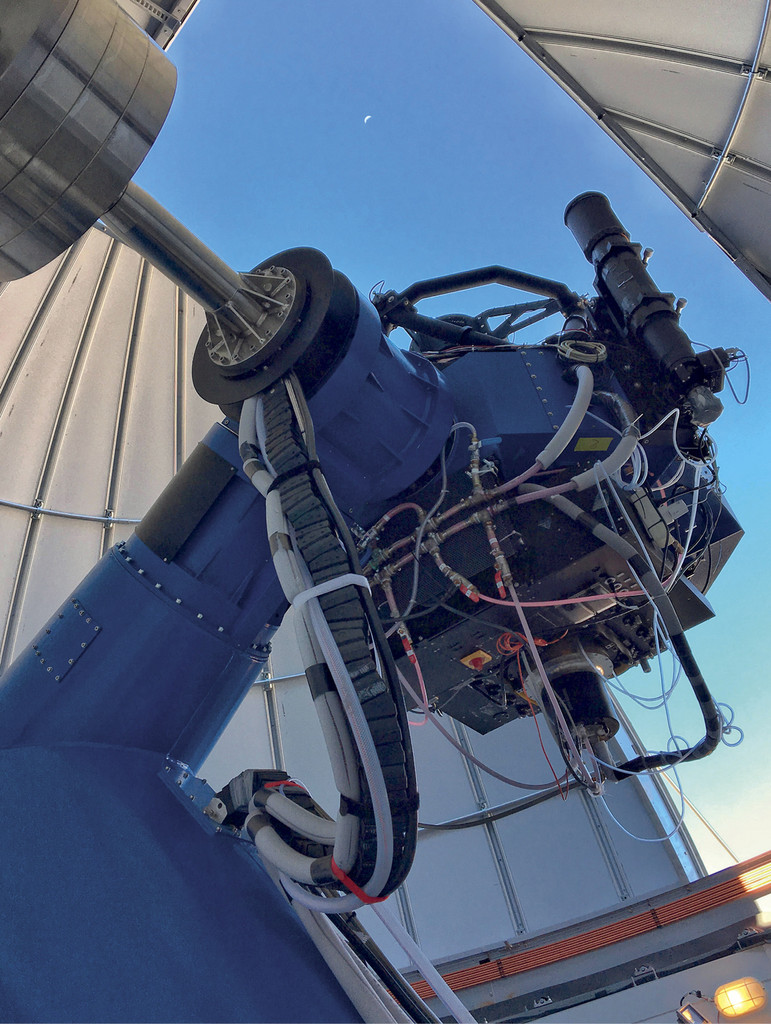
ALBERTO MOLINO
The T80-South telescope, a Brazilian project located in Chile, also recorded the phenomenonALBERTO MOLINOOf the 70 or so ground and space instruments that observed the electromagnetic radiation of varying wavelengths emitted in the two weeks following the neutron star merger, another small telescope, also located in Cerro Tololo, was operated by Brazilians. The T80-South has a 0.8-meter mirror, but its camera has a field of view eight times larger than the Swope Telescope. This makes it ideal for scanning vast areas of the sky in very little time. “We obtained the data as part of a network of small telescopes called the TOROS collaboration, which attempts to locate electromagnetic emissions associated with events that produce gravitational waves,” explains astrophysicist Claudia Mendes de Oliveira, from the Institute of Astronomy, Geophysics, and Atmospheric Sciences at the University of São Paulo (IAG-USP), who founded the T80-South project.
The telescope only located the optical emission produced by the merging neutron stars on the second night, after the team received the coordinates of the object in several circulars, about 35 hours after the first alert was issued by the LIGO-Virgo collaboration. “We were unlucky. On the first night, we looked at almost half of the area, but we started on the opposite side of galaxy NGC 4993,” says Claudia. Even so, the T80-South took important measurements and its data has been used in two scientific papers published on the electromagnetic emissions produced by the collision.
The T80-South works robotically and can be remotely controlled from anywhere on the planet. The instrument, which began operating six months ago and cost just over US$2 million, was funded by FAPESP and the Brazilian National Observatory. Its primary function is to survey celestial objects in the southern hemisphere across 12 distinct spectral bands, but it can also be used for other specific purposes or targets, such as the search for light emitted by two colliding neutron stars. In the second half of 2018, when the three gravitational wave detectors resume operations (they are currently offline), the T80-South and other LIGO-Virgo partners may have another chance to find signs of electromagnetic radiation produced by explosive events occurring in some distant corner of the universe.
Project
EMU: Acquisition of a robotic telescope for the Brazilian astronomy community (No. 09/54202-8); Grant Mechanism Regular Research Grant – Multiuser Equipment Program; Principal Investigator Claudia Mendes de Oliveira; Investment R$5,075,402.98.
Scientific article
DÍAZ, M. C. et al. Observations of the first electromagnetic counterpart to a gravitational-wave source by the TOROS Collaboration. Astrophysical Journal Letters. V. 848, No. 2. Oct. 16, 2017.